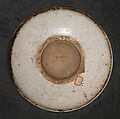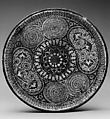Dish
Not on view
This dish resembles a number of other nineteenth-century examples from Central Asia. They are all made of earthenware covered with a white slip, and are painted with red, green, azure, and yellow designs under a transparent glaze. These designs exhibit both local artistic traditions and influences from China, Iran, and the Ottoman world, which reflects the region's position on well-traveled trade routes. Under the rim of this dish is a band of grillwork design, and at the center of the well there is a rosette surrounded by a band of reciprocal leaf scroll. Between these two areas are two pairs of circles with spiral designs, and two ovoid cartouches filled with palmettes, rosettes, and scrolls. The combination of blue glaze on white pottery, as well as the scrollwork, are said to come from China, but the rest of the patterns are of local invention.
This image cannot be enlarged, viewed at full screen, or downloaded.
This artwork is meant to be viewed from right to left. Scroll left to view more.




